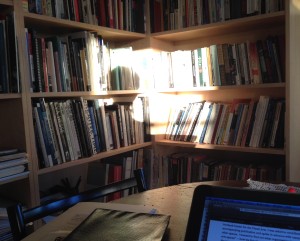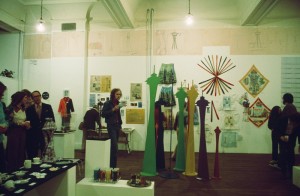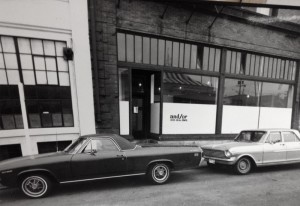The setting sun lights up my library corner on the last day of 2015.

The morning sun shines on a determined rose blooming on the first day of 2016.

![]()
The setting sun lights up my library corner on the last day of 2015.

The morning sun shines on a determined rose blooming on the first day of 2016.

![]()
Last November, Temporary Art Review published an excerpt from a longer essay of mine, “A Pragmatic Response to Real Circumstances,” originally published in 2006. The focus of the piece is and/or, an artist space that I helped found and then directed during its ten-year lifespan, 1974-1984. The publication has a specific focus on “self-organized and artist-centered spaces and critical exchange across the United States and beyond.”
About itself, the Review says:
Temporary Art Review is a platform for contemporary art criticism that focuses on alternative spaces and critical exchange among disparate art communities. Temporary is an international network, highlighting both practical and theoretical discourse through reviews, interviews, essays and profiles on artist-centered spaces and projects.
The publication was founded in St. Louis in 2011 by Sarrita Hunn and James McAnally, has a national network of contributors, and aims to decentralize the conversation about contemporary practice by emphasizing the breadth of projects taking place outside of traditional art centers. In fall 2015 it profiled spaces in the Northwest, several each from Portland, Seattle, and Vancouver. Their interest in the history of artist spaces led them to and/or. I’m grateful for their interest. You can find my piece below and on Temporary Art Review’s site here.


In the early ‘70s a group of artist friends took the name “Seattle Souvenir Service” and attached it to various art projects: actions at art festivals, little books, a growing accumulation of Space Needle memorabilia — plates, ashtrays, pennants, records. It was a very unstructured and convenient alias, which we used sometimes individually, more often as a group.
At some point, for reasons that escape me at the moment, I wanted a more formal structure and my mind was set on a nonprofit organization. I imagined and outlined the cluster of activities the new organization might encompass. First, we’d have a space — for videotape and film showings, performances (experimental music, dance, and theater; electronic music, video performances, poetry readings), exhibitions (work not being shown elsewhere, conceptual and correspondence work, “environmental” or what we’d now call “installations,” the Space Needle collection), special events for women, and workshops, discussions, and parties. Second, we’d have an art services business including production and exhibition services, management advice for organizations (think of it!), and a workshop space that I already had under lease (electronic music, carpentry, storage). And we’d have equipment — video, music, film, chairs.
After laying out the big picture, I was told by Bob Kaplan, an attorney who has given advice to many artists over the years, that all this wouldn’t fit into one legal container; some activities could function under a nonprofit umbrella, but others, he said — the art services in particular — were commercial, profit-making activities. I couldn’t have both. He played a good devil’s advocate role on behalf of a profit-making structure, but I went with the nonprofit anyway. Setting up a legal entity felt much like a game, at least at the beginning. We were playing at being “directors.”
After finding a space, I convinced my dad (who with mom had promised a loan, of equal size no doubt, to each of their children) that starting this place was as good a use of a loan as buying a home (something I didn’t own then, indeed only came to own at age 53). He gave me about $1,500-2,000 up front for labor and materials to remodel the space, and then a monthly amount of $200 for the first year, an amount he cut back incrementally each month after that, to zero at the end of the second year — probably a total of $5,000. Knowing I had that support, I then convinced the city to let me quit half of my full-time job with the two-year-old arts commission, giving me time for the new venture.
Although pretty much the same people were involved, we decided that the “Seattle Souvenir Service” should remain loose, unconstrained by any legal structure. So the new place needed a name. Wanting it to stay open to possibilities, I settled on and/or. A typewritten doodle at the time put it like this:
and/or
AND/OR
and/or
and/or VIDEOTAPES
and/or SPACE NEEDLES
and/or NEW DIMENSIONS IN MUSIC
and/or ARTISTS’ BOOKS
and/or opened on April 21, 1974, the Space Needle’s birthday.
*****
Two years later, we held a staff show (there were five or six of us at that point) to let our audience see more about who made decisions and ran the place. I contributed Making a Habit, a daily public writing project, posting one new page every day. Since I continued to think about the patterns I made through and/or, one day I wrote:
Somehow it’s fairly easy to see the initial setting up of and/or as an artwork — creating, making the space, making an organization where there wasn’t one before, pulling ideas together that eventually became the programs, the general definition. It’s more difficult to describe the ongoing of it as an artwork… One of the greatest challenges is working with an ongoing form; the “trick” is not to simply have an organization that perpetuates itself, but to have one with life, challenges, risks, and new ideas — that also manages to have a life span.
I’m often involved in finding a very tricky, delicate balance between giving enough structure, stability/credibility to assure a continued existence, and giving enough openness, flexibility, free-ness to allow for real growth, surprise, significant work and change.
One concern was how to make a situation, a pattern, that didn’t predetermine the results any more than necessary — giving the participants (artists) the greatest possible chance to develop their own ideas… At the same time I realized that no matter what I did I wouldn’t create a neutral or totally “objective” pattern even if I wanted to (which I often thought I did).
*****

In 1978, the first gathering of “alternative visual arts organizations” took place in Santa Monica, California, attended by fifty-seven organizations, including and/or and the Portland Center for the Visual Arts. I was asked to contribute an essay for an accompanying publication and spoke in advance with many of the artist organizers of other spaces. I wanted to find out what organizational patterns we had developed as “new arts spaces” — how we functioned and what shapes we had taken. I was also interested in the ways our organizations had changed.
An overriding memory from the conversations, one that didn’t get into my essay, was of terrific disappointment. I took on writing the essay because I thought it would give me a chance to talk with other artists who were thinking about the patterns of their organizational work. I was surprised that I didn’t find anyone who thought about making the organization as an extension of their artmaking. Maybe I didn’t ask the right questions. They often knew that being artists themselves was important to the work, but in most cases they also seemed to feel that the organizational work took them away from their art, and many of them longed to get back to it. Many worried about their spaces becoming institutions (though some explicitly sought that), while it seemed to me that their organizations followed existing organizational models without thinking much about it. Now, I find it curious that I didn’t write about my dismay. Perhaps I didn’t quite know how to bring it up or, as likely, was insecure about being so alone in my interest. Here is part of what I wrote to my colleagues:
As our prestige and reputations increase, as we increasingly have something to lose, it could become harder to take risks, to risk failure, to risk not living up to our own standards. Risks were not difficult when we were fairly invisible. I cannot believe that we’ve learned enough that risks are no longer necessary. We also need to remain fluid and flexible, to anticipate and be ready for change in ourselves, in the questions we answer, in the artists and work we support.
An ability to change seems a crucial part of any organizational pattern, especially a “new” one. It also seems important to find out how our structures have changed over their three- to six-year lives. We should ask what we face now that we did not face initially, how each of our organizations deals with becoming an institution itself, and how we can retain the kind of energy and vitality that got us started.
*****
Good Night and/or A Wake
In 1983, and/or received one of the biggest grants that the National Endowment for the Arts offered to smaller organizations, an Advancement Grant. This program aimed to help organizations with strong artistic programs become stronger organizationally (management, finance, fundraising, etc.). These days it would be called a “capacity-building” grant (look that up on the Jargon Files). The award involved a year’s work with a consultant, the development of a multiyear plan, and then a sizable grant (approx. $25,000) in each of the following three years.
After a failed effort to buy the building that housed and/or, I had one of those all-of-a-sudden moments when a new option opens up. Usually my course of action moves along incrementally, listening, making small changes, being persistent, bringing a good idea back, learning from someone else, helping the direction shift — a little like following a winding path. But once in a while a whole picture comes to mind in a flash, and then the challenge becomes understanding its implications and finding ways to act on it. I decided to close and/or — something flipped over, and closing down became the way to advance.
The idea came in summer 1984, and we celebrated with a big party in October that same year — “Good Night and/or A Wake.” I managed to convince the NEA that we should keep the Advancement Grant and use it to support our existing program divisions so they could develop as independent organizations.
In one of the many pages of notes I wrote to myself and others to understand why this was a good idea and what it meant, I gave a quick historical view: “and/or started as an artistic entity, initiating programs and seeing itself as a unified whole. Then some of its programs began to develop stronger identities and a distinction began to be made between ‘and/or core’ and program divisions (exhibitions, music, library, media arts, a small grants program).” The decision to “end and/or” meant closing down the core, not the divisions. I recommended to the board that this be done very publicly because that would:
Reading those documents makes me conscious of how differently people can view the same events. I respect what’s in all those notes as a slice of the history, though the history is bigger than that. Much tension ran through and/or at the time; it was loaded with internal power dynamics. As an organization, its time had run out; contention and power plays seemed stronger than vision and commitment. “In many ways,” I wrote at one point, “it feels much healthier to put energy into the offshoots, the activities with more focused definition, than to spend a lot of energy trying to preserve or to breathe new energy into the original shell.”
A couple of years ago there was a little burst of local interest in the death of organizations. I was invited to participate in several public conversations — “When Things Die” and “Life and Death.” I became the celebrant of dying. An announcement at one such discussion outlined the three stages of death: “denial, anger, acceptance.” For my part, I amended it to add “chaos, release, rejuvenation.” About and/or I observed:
and/or was not built to last, profoundly not. Its energy went to doing, not to building a lasting structure. In the end, it seeded, divided, dissolved its center. It was allowed to become “myth,” to have a beginning and an end.
*****
This essay is an excerpt from the chapbook, “A pragmatic response to real circumstances,” available from Publication Studio Hudson, originally commissioned and published by the Back Room, Matthew Stadler, editor.
© Anne Focke 2006
![]()